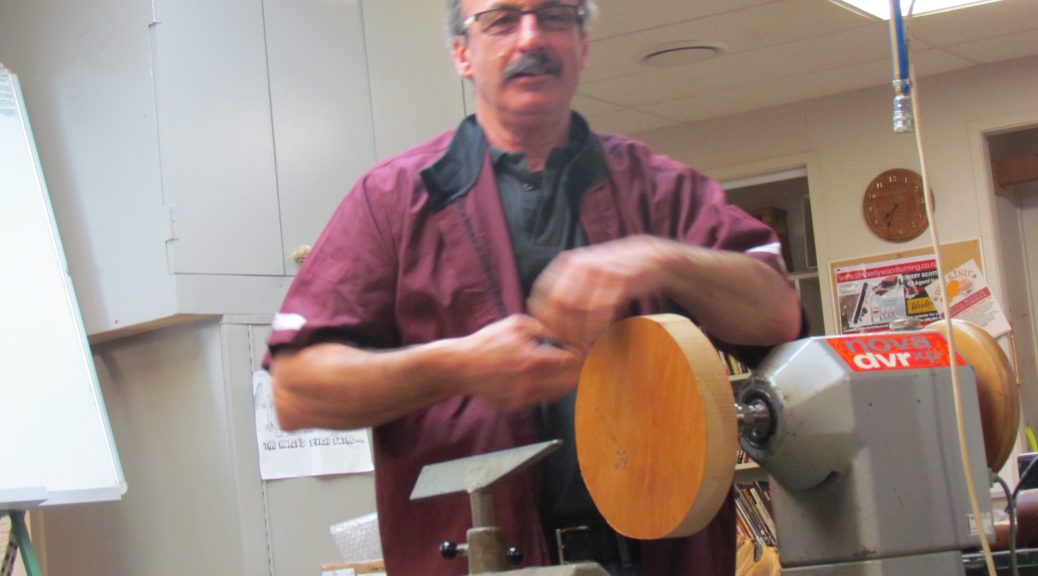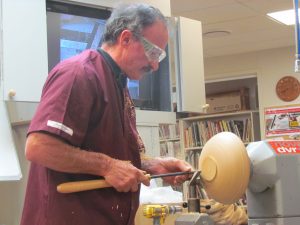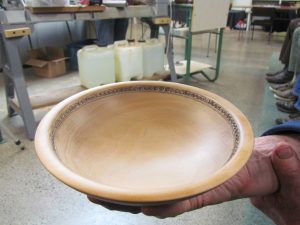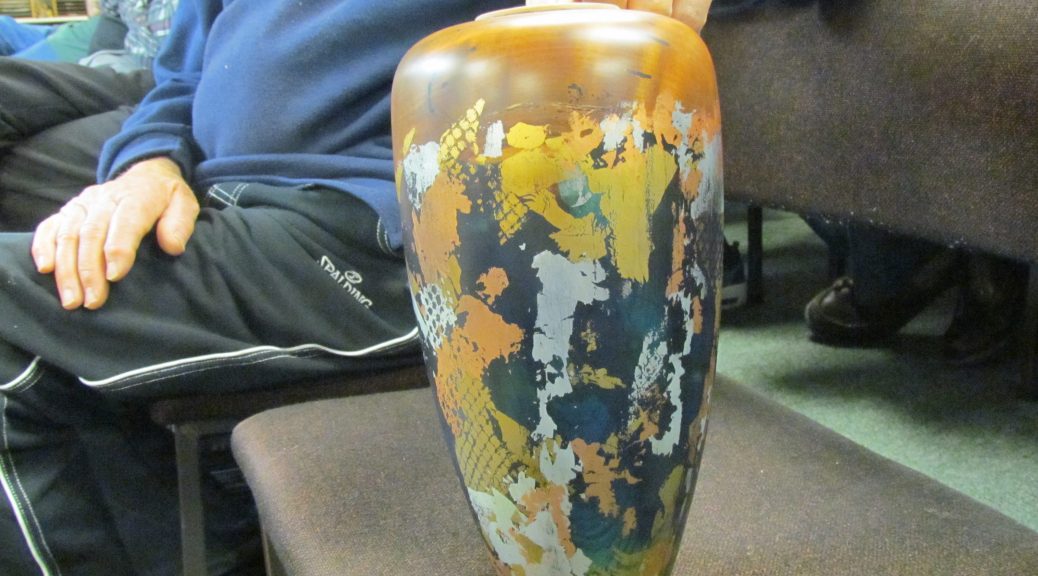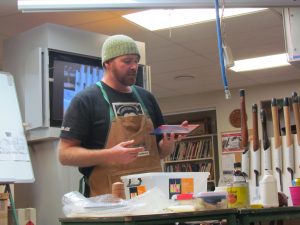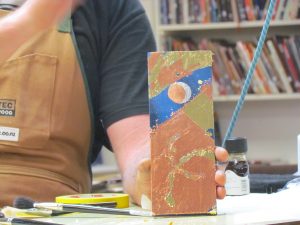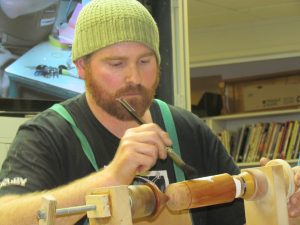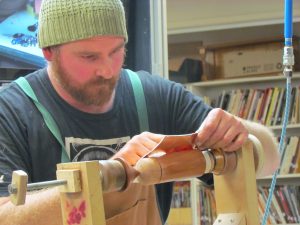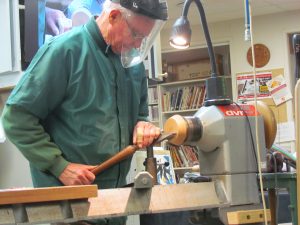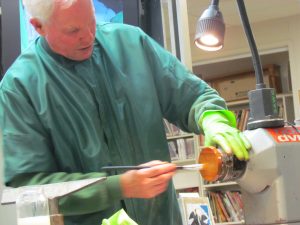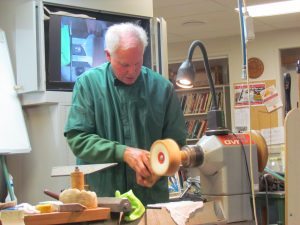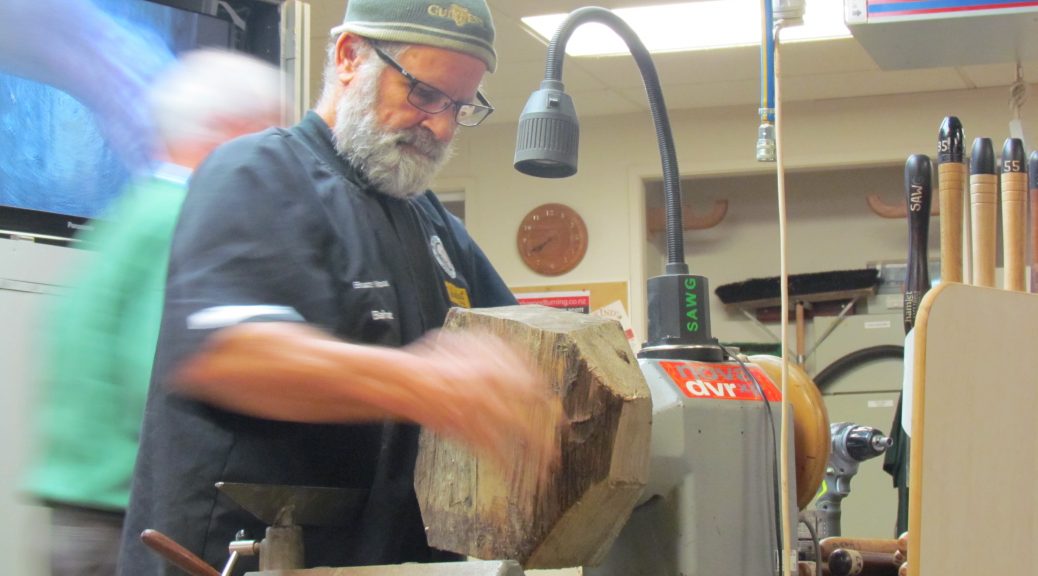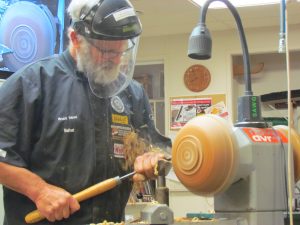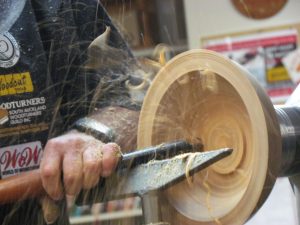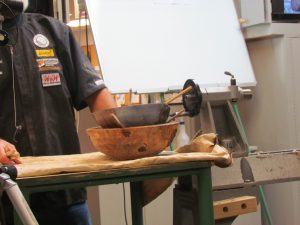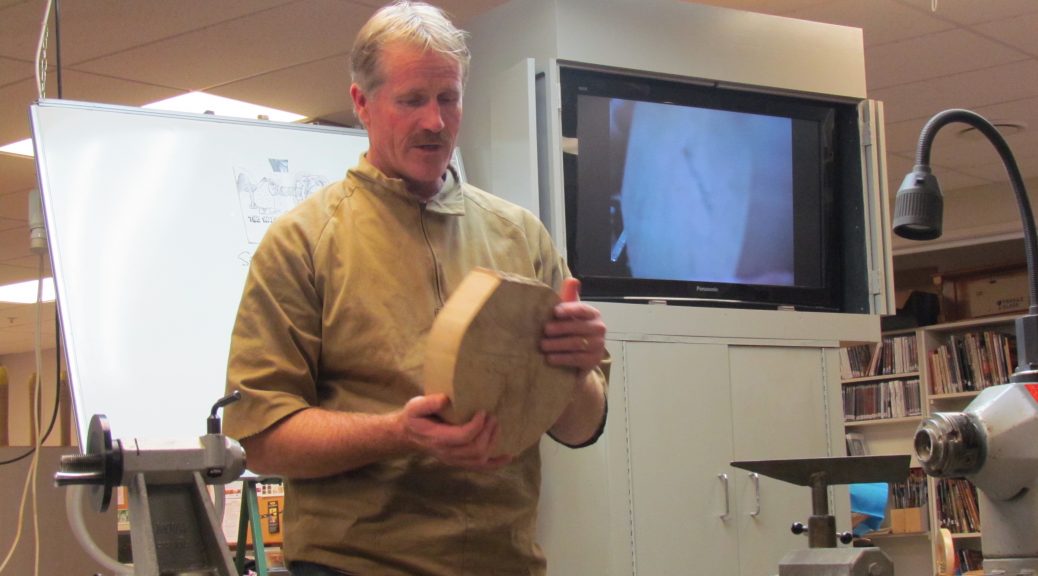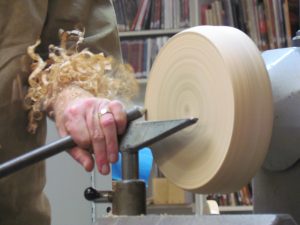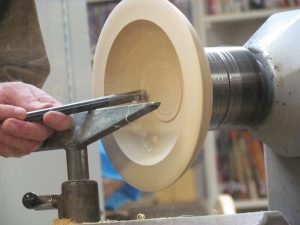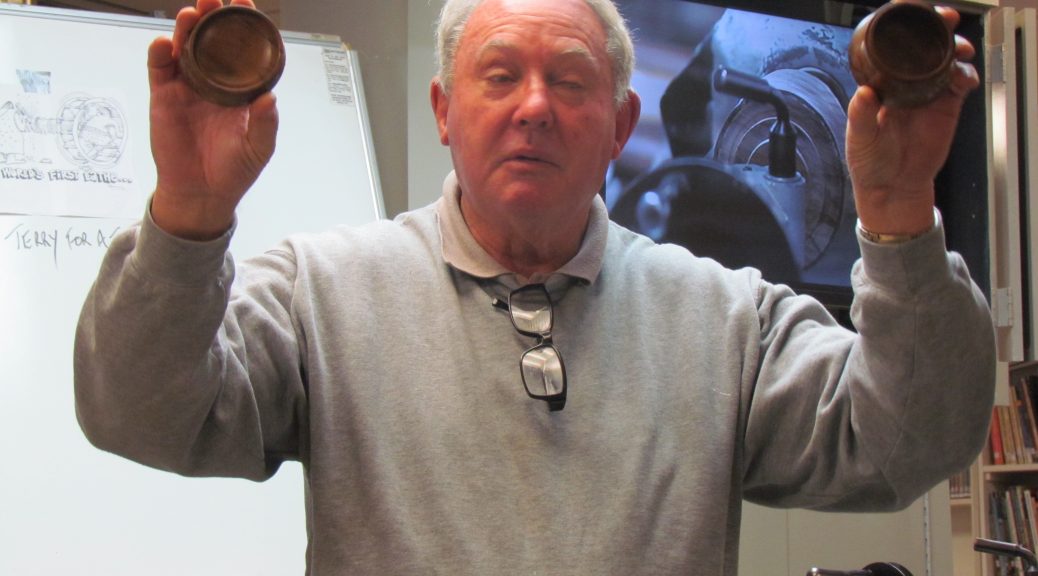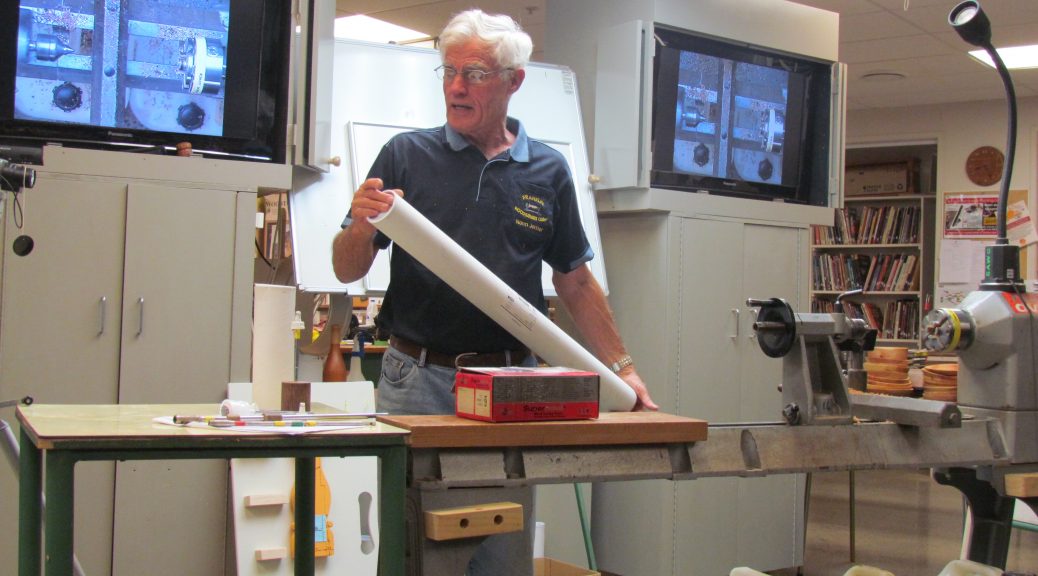Category Archives: News
Pyrography – Terry Scott
Club Meeting: 3 August 2016
Author: Richard Johnstone
We had another excellent demonstration from Terry Scott . The theme was pyrography, but you know that you’re always going to get more with Terry.
Terry began by demonstrating shaping the outside of a bowl and getting a smooth finish (before sanding) with a shear cut using a skew. This technique will probably take some of us a fair bit of practice and a few dig ins to perfect.
For his “craft” bowls Terry uses the spigot as the foot of the bowl and turns the foot nearly to completion. When the bowl has been completed he just turns it over, uses a Steb Centre to hold it against a face plate, and curves the sharp edge of the spigot. The clever part was how the centre of the foot was turned out to the size of a Paua dot or a Penny. The marks of the Steb Centre were then covered up with a value add process and didn’t need to be sanded out by hand afterwards.
Terry’s carved and embellished pieces always look as if the pattern has happened randomly, but there is a bit of planning and preparation which goes into that random look. Terry uses the indexer on the lathe to give even segments to his patterns. This prevents working around the bowl or patter and having an uneven gap left at the end.
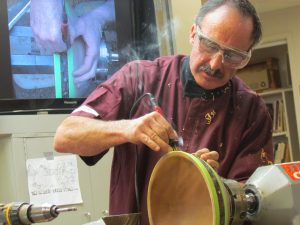
He moved on to Pyrography and showed us various methods of producing patterns using both commercially available tips and custom designed tips made with Nichrome wire. The variations are only limited by your imagination.
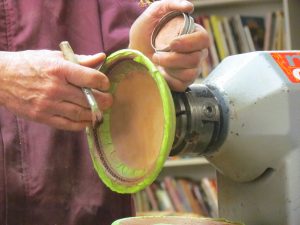 The final piece of the puzzle was supplied by colouring the various embellishments. Terry’s choice of colouring medium is guilders paste. By adding different colours or by putting colours on top of each other he was able to get some stunning effects which really added to the overall “wow” of what Terry demonstrated.
The final piece of the puzzle was supplied by colouring the various embellishments. Terry’s choice of colouring medium is guilders paste. By adding different colours or by putting colours on top of each other he was able to get some stunning effects which really added to the overall “wow” of what Terry demonstrated.
This demonstration was everything we have come to expect from Terry. There were lots of ideas for decorating bowls and platters using texture, burning and colour. Everyone would have gone home with something to inspire them. Thanks Terry.
Gilding – David Gillard
Club Meeting: 27 July 2016
Demonstrator: David Gillard
Report by: Graeme Mackay
David’s humour comes through early. He opens a demonstration with this take on gilding and the use of a special gilder’s pinafore or as we commonly known as a pinny. Through this initial humour David started the theme of planning and preparation and time to carry right through the process.
The embellishment process of gilding requires planning: choose a surface, prepare it well, Sand well and make sure the shape is clean. Gilding is an addition or an embellishment. It does not cover up lack of form, mistakes or hiccups.
Checks and steps: overall gilding is a simple process where a medium (size) is used to hold a thin metal foil onto a prepared surface. David stated that it is all in the planning and ensuring that the correct material processes used for each step.
Size; the medium to hold everything together. The use and drying time means checking the type of size and ensuring that you have the correct medium i.e. oil or water-based. Check; the drying time for this type medium when considering the atmospheric temperature and humidity.
Leaf: which one, which type, what are the restrictions. David demonstrated a range of loose-leaf and packet foils in both metals and plastics. And, showing how each one has to be handled, placed with much laughter in the correct place. The key message was try each form and see how it works for the effect you want to achieve.
Sealing the wood: Dave commented on the need to ensure that the base was sealed and cured. He made mistakes and not wiping all the sealant dust off. I repeated the message to think through the finish. What you want to achieve. And as with all demos think through the process and keep the dust away in a normal workshop conditions are means ensuring that the dust filtering processes of their and that the correct material sealant size or shellac finish is available to be used.
Brushes: a small range is useful for starting up David recommended find him brushes with differing densities. Offering that the density dependent on what part of the process you are doing and that cotton buds are a good fill-in for brushes.
Filtering: David felt the filter on the size or of finish was important. He felt that avoiding synthetic materials for filtering and that using natural materials with that option. He was able to purchase some silk cloth offcuts and reasonable price to use for filtering.
Application of size: David suggested that an airbrush would provide a useful application of size and provides an even finish. This is also a follow-up in the comment of filtering the size material before use.
Holding mechanism: David wanted a holding mechanism that provided two hands free for the many processes of gilding i.e. such as applying size, leaf and finishes. The photo below shows a simple mechanism made without advanced workshop machinery or the need for extremely finely detailed precision engineering.
The simple mechanism uses standard timber bolts and turned bits with a simple slide to make quick adjustments. Dave calls the apparatus to hold the piece a fancy F clamp with a base to stop it falling over.
Purchasing the products: another cheerful checklist from David for purchasing size, sealant and leaf. While the reasons for checking the details before purchase were put forward with great humour, the core exercise still important. Nothing the standard and you often pay too much for too little.
What are the specifications of the size?
How many sheets do you get?
What is the actual colour?
What are the dimensions of the sheets?
Why: gilding as a visual tweak
David commented that the visual and embellishment components are part of the planning working up of a piece.
Gilding is an embellishment which can provide a new visual tweak to a piece.
And, more importantly, that this visual tweak is for the view from the outside.
David believes that it is good to get the outside view versus that of the woodworkers or Woodturner.
The demo provided a good reason to try this line of embellishment. There will be a follow-up article on technical parts of entry into embellishment tree gilding.
July 2016
Finishing – Lindsay Amies
Club Meeting 6 July 2016
Report by Earl Culham
Lindsay’s demonstration commenced with the comment that there are two stages to finishing, firstly to finish your piece to a high standard with chisel and sand paper followed by the application of an appropriate finish for the type of wood used.
Stage One
To demonstrate stage, finishing your work to a high standard; Lindsay used some demolition rimu which in his terms was “manky”. By manky, he meant that the fibres in aged timber start to breakdown making it difficult to finish with the chisel especially on cross grain. It is easy to get a tear out and if you try to sand the defect out, it is easy to get heat checks when working with rimu. The only way to remove heat checks is to cut them out with the chisel.
It is essential to have a very sharp chisel and use fine cuts to achieve the desired smooth finish prior to sanding. Use as high a speed as you are comfortable with when making the final cuts and reduce speed for sanding.
Lindsay used drinking straws to demonstrate the best technique for cutting through fibres rather than tearing them e.g. a straight cut across the fibre will tend to tear rather than cut. Cutting at an angle across the fibre will achieve a smooth surface.
Rimu is a very dusty wood when being sanded and the dust can be quite irritating. Use a dust mask for protection and ondina oil is useful to reduce the dust. Sand through the grades to 400 grit or higher if you wish.
There was a suggestion from the floor to use sanding sealer before using ondina oil so that it didn’t soak into the end grain and cause the end grain to be darker than the rest.
Stage Two
There are many different types of finishing products available and it is a matter of personal preference which you use. Lindsay used the following products to show the different finishes that can be achieved:-
Briwax on its own, the result was a low sheen.
Sanding sealer applied and then the wax gave increased sheen
Boiled linseed oil thinned with vegetable turpentine by 10-15%, low sheen.
Sanding sealer applied and then the boiled linseed oil mixture, increased sheen.
Wattyl lacquer, thinned by 50%, high gloss.
Beall buffing system, using Tripoli, White diamond and Carnauba wax, produces a high gloss finish.
Thanks Lindsay for a well prepared and informative demonstration. We are all aware now of the pitfalls associated with “manky” rimu.
Wet Turning – Bruce Wood
Club Meeting: 29 June 2016
Report by: Strett Nicolson
After a brief introduction explaining the ‘what’ and ‘why’ of wet wood bowl turning Bruce mounted a piece of wet swamp kauri on a face plate using tek screws. Because the blank was rather more unbalanced than expected the start turning speed was 250rpm. For safety sake he brought up the tail stock and used the full face mask until the wood was more balanced.
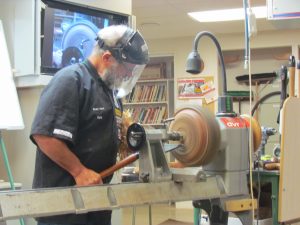 At this point, using a skew chisel ( and obviously a stationary lathe) he dug out loose bark to check the depth of the bark. He then flattened the face , marked the center and cut a 100mm spigot with his “ make it your bloody self” tool.
At this point, using a skew chisel ( and obviously a stationary lathe) he dug out loose bark to check the depth of the bark. He then flattened the face , marked the center and cut a 100mm spigot with his “ make it your bloody self” tool.
Floor question: Would you use a bowl saver tool on a piece of wood like the one you are turning now? Answer, “No!”
While hollowing out he suggested that a wet bowl needs to be about 25mm thick and an even thickness at the bottom of the bowl as well. Then marked and cut a recess of 70mm in the inside of the bowl , not forgetting to mark the centre again for accurate remounting once the bowl is dry.
Floor comments: 1. To remount one can also turn a plug and glue it in the recess. 2. A spigot can be left on the inside as well.
Remove from lathe and paint with log sealer and store for 12 months or dry by freezing and placing in fridge for 2 weeks. The bowl will lose approximately 1/3 of its weight by the time it is dry so it is important to weigh and record the wet weight, then check weight loss regularly till satisfied it is dry enough to finish the turning.
Complete the bowl once dry ( 12 months later) remembering that in the drying process the bowl may be as much as 5mm out of original shape. Take this into account when deciding on final shaping.
To remove the foot on the bottom of the bowl fix the bowl in a rubberised face plate and hold up with tails stock, or using cole jaws set to size, or fix with vacuum chuck and hold in place with tail stock.
Floor Question: Because log sealer is a lubricant, is there a chance that the jaws won’t hold the bowl safely? Answer, “No!”
Bud Vase – Warwick Day
Club Meeting: 22 June 2016
Report by : Bob Yandell
Warwick again showed the value of preparation and research in making an entertaining and informative demonstration.
A range of images of Bud Vases observed in the homes of friends, with each having their own personal story, was complimented with images from around the world made in a variety of mediums – porcelain, copper tube, clay and wood. The examples presented showed us there are many shapes and colours in the humble bud vase.
Warwick had reproduced examples of these various shapes in wood and enhanced them with colour. He also used coloured pencils glued together resulting in an interesting product. Warwick selected one design and proceeded to demonstrate how to produce the design.
The presentation was punctuated with key points to remember in using specific turning tools and finishing techniques.
The following steps and points are the basics:
- Square the piece of wood – Macrocapa was used as it is a stable timber
- Hold between centres and roughly shape using roughing gouge
- Cut a chuck bite on the drive end using a Parting or Bedan Parting Tool
- Mount in chuck – using skew chisel achieve a clean surface using a planing cut
- Drill the hole in the centre using the appropriate size drill. Slow and smooth, clearing frequently 600rpm – your choice of drill is yours but the key differences and idiocrasies are as follows
- Auger – lead thread will follow the grain so either be very careful or drill a 6mm pilot hole to eliminate the threaded lead.
- Engineers – the diamond shaped point
- Brad – point like a brad
- Forstner – Straight edge for end grain; saw tooth for cross grain
- Use live centre with an extension the same size as the hole to support the wood during shaping
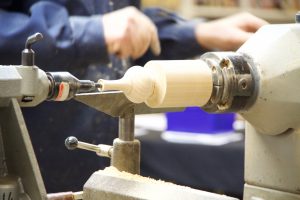
- If copying an existing design, you can use measurements or a profile gauge to determine high and low points. You can position in the same plain behind the wood being turned to view as you turn.
- Mark the highs and lows in pencil to give a reference point
Turn final shape and tidy mouth with the spindle gouge – Sharp tool and slow steady - Sand – go through the grits. Store sand paper in a “file box” made to size (1/4 sheet) and have dividers to keep grits separate. Use a marker/stick to indicate where you are in the process
- Colour -Water based. Layer and dry with hair dryer or go and have a cuppa. Burnish with a sanding pad or steel wool between colours. Warwick used Blue, Green Light Green and highlighted parts with Red
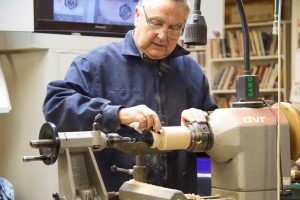
- Finish with what you use. Stick to the same “Family/Brand” group e.g. Triple E and ShellaWax from U-Beaut Enterprises .
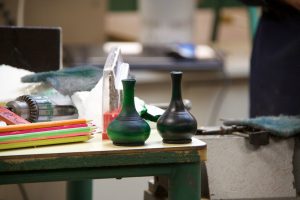
Bowl – Richard Johnstone
Club Demo: 15 June 2016
Written by Graeme Mackay
Richard started with a cheerful introduction and gentle lead in by opening with his key point; the need for sharp tools, always, sharp tools. Also, he reinforced the need to keep doing the sharpening. Not only that, he remembered the colour of the honing bars red blue yellow or was it yellow blue red. Whatever the colour or the system, the basics are sharp tools.
Naming your blanks: when question image and he puts his both date and name on the blanks when they are shaped. This protects a piece against all comers and has several sons. A good basic idea that gives an indication of when this piece was shaped up and put out for storage.
In all standard starts, Mark the centre before putting on the faceplate and again before that, with great humour, discuss the options (as Richard noted even with yourself) and ensure the screws and holes the right size. Sometimes a simple operation that is missed.
The steps are straightforward and available on our club website. Go through the steps and verbalise each part of the process. Richard commented that saying is allowed often helped keep things ordered and avoid missing steps.
Restrain the aggression: when cleaning up the faceplate and getting things ready avoid being aggressive. Get the blank and balance and then start working on your plan. That is if you have a plan or a drawing. A point taken up not too much later in the demonstration.
Check your measurements: Do you have the correct chuck bite? Do you actually know the correct size? Do you have something to measure things with? All this to avoid later readjustment and correction of any miscalculations. A good direction for getting back to basics.
The correct gouge: Do you have the correct gouge are making the rebate? And as Richard corrected the taper of the rebate he commented; did you checked instructions? Sometimes it’s the little things that really miss you up when you have to go back. Marking a bottle spot will resist resend train if needed corrections. Think through the process for the shape you want. Have you thought about the foot? Richard cheerfully mentioned the need for planning and drawing. A basic feature which helps that particularly nearly days of the first 200 bowls.
The foot: have you made a decision. There is a need to plan early and ensure that the correct amount of wood is left for the type foot that you’ve decided upon. Sometimes simple questions such as “is it easy to sand” will assist in back to basics approach. Again the cheerfulness Richard said look at the shape you have chosen and make sure that you have the appropriate tools close by and sharpened. All these items are on the checklist. If you can print them off.
Working through the items on the checklist avoids the need to go to Plan B or plan C or plan D….
Along with this approach is a need to have your body position worked out. Ensure you have the correct placement of your feet. Can you move freely and complete the cutting exercise without interruptions making those lovely bumps and humps. Richard returned the conversation to early planning and the oft missed drawing a diagram. Planning can mean room for options; is there room on the rim to have an undercut. Will you be able to use some of the attractive grain in the wood?
A good joke about callipers; if there are no batteries for the digital callipers, do you have the batteries to run fingerometer to judge the thicknesses. In a back to basics approach, it is good to think about how you’ll take the spigot off. Some prior thought, and even some prior planning will make this a little easier and probably provide a better visual finish.
Richard commented that in this back to basics approach; just slow things down. Don’t rush. Have a thought about things, sharp and tools and enjoy yourself.
Golden Section Gauge
Lidded Box – Cam Cosford
Date : 25 May 2016
Author : John Whitmore
The intention was to take the audience through the basic procedure of making a lidded box (instructions can be found on the SAWG website). This morphed into a version that Cam makes based on the style of a Guilio Marcolongo jewellery box and characterised by a flared base; and with a top that is both flared and off-set. The point of difference was in using a Vermec Multi-Centre Chuck, theatrically described as a ‘wobbly chuck’. For simplicity of description, sanding and finishing stages are omitted.
The starting point was a side grain cylindrical blank of (unidentified) timber of 95mm diameter and at least 95mm long. This length allows enough waste for a sacrificial foot and from the separation of lid from base – but all dimensions are, of course, variable according to individual taste. 50mm spigots had already been turned on both ends, plus a drilled hole in the waste at the base end that would later be attached to the ‘wobbly chuck’. If matching of grain is desired, the likelihood is that straight-grained timber used in end grain format, will be necessary.
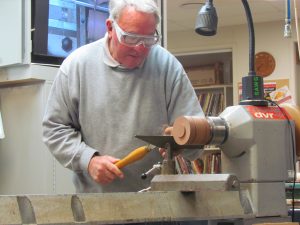
The blank was held between centres by 50mm jaws with a Steb live centre as tailstock support. 22mm was parted off at the tailstock end to form the lid section, reversed and mounted into 50mm chuck jaws using the existing spigot, for later use.
The remaining, larger, base section was drilled close to final interior depth using a 60mm Forstner bit and finished with skew and square ended scrapers. The interior wall line was flared to approximately match the intended later flare of the outside. At the same time the rebated step for fitting the top, was formed, and must be parallel to the box axis.
It was now time to remount the lid piece in the 50mm chuck jaws ie with the eventual top surface facing the headstock. At this stage the lid was hollowed out and the corresponding rebate cut to match the base rebate, with a close interference (ie jam) fit.

The base plus fitted lid was then mounted as one unit on the ‘wobbly chuck’ (set to zero and held in conventional jaws) – with the Steb live centre brought up for support while the outsides of both parts is ‘coved’ together to create the outside flare shapes. After this, tape is used to firmly secure the top to the base section and the tailstock support is removed. The spigot was turned off while the work was still on-centre; then the ‘wobbly chuck’ was adjusted to give whatever degree of offset is desired (in this case #24). Careful, offset doming of the lid was conducted by cutting with a bowl gauge against the grain (ie from the outside) to minimise edge chipping.
Discounting sanding and finishing, the final task was to separate the parts and reverse the base onto chuck jaws to turn off the waste wood into which the ‘wobbly chuck’ was screwed.
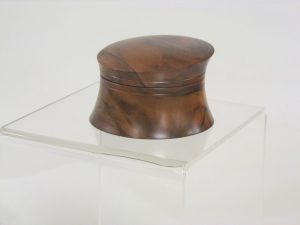
Lidded box enthusiasts will be able to devise their own dimensions, styles and preferences based on this soundly demonstrated format.
Pepper Grinders – Norm Jenner
Club Meeting : 25 May 2016
Report by: Phread Thurston
Norm knows quite a bit about pepper grinders. So lets get the confessions out into the open straight away. This writer has never made one. But this will not stop me describing Norm’s presentation. I do know that I will make one in the future as it’s not too daunting.
Instead of turning timber Norm has a presentation board with the stages of the process in live form mounted upon it. He then described each stage and some of the pitfalls that he had to overcome. In discussing the presentation with another woody it was mentioned that you can see five or so pepper mill presentations and they will all tackle the task in a different way.
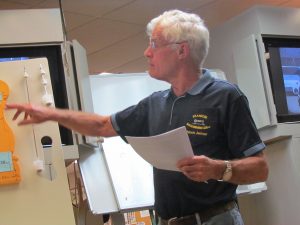
Now having shown how Norm went about the evening’s demonstration it’s not going to be written up here with all the instructions on how to make pepper grinders.
It is very clear that this is just not possible and if an error in the process is made then it’s in fact not even helpful. But don’t fret if you want Norm’s detailed instructions given to the writer on the evening then contact South Auckland Woodturners Guild’s Secretary, provide your email address and a copy will be sent to you.
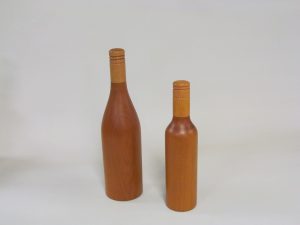
Norm’s presentation was relaxed, interactive and covered all the trouble spots involved with turning pepper grinders. With no actual turning the subject matter was covered quicker than it would have been otherwise. However if we had turned one from go to completion it would have been very late indeed when we left our clubrooms. The Crushgrind mechanical grinding mechanism is the preferred peppercorn grinding mechanism. Cheaper mechanisms should be avoided as they will just not last. Only two pepper grinders had been returned with problems. Yes one of them had just simply run out of peppercorns. Obviously Norm makes quality grinders. He likes Forstner bits for doing the drilling and even though he sharpens them contrary to good practice ( honing the flat and not the bevel is good practise ) he has never had a problem. He uses a very narrow saw when parting the top from the base. The basic reason is to preserve the grain. He likes Danish Oil to finish the grinders.
So the evening came to a close. Norm did put a few shavings onto the floor just to give the nominated sweeper a job to do that night but this small part of the evening was not about pepper grinders. Thank you for your demonstration Norm and yes I will have a go at making a pepper grinder.
